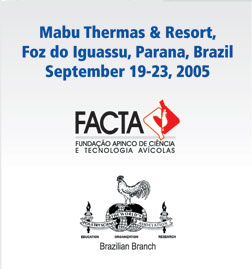Immune reactions to different doses of Eimeria Acervulina
in day-old broilers.
W.J.C
Swinkels, W.A. Boersma, JMJ Rebel.
ASG Lelystad p.o. box 65 8200AB Lelystad, The Netherlands.
E-mail: willem.swinkels@wur.nl
T-cell
responses are the dominant immune reaction in broilers
infected with Eimeria. Different factors that may
influence the kind of T-cell responses to an Eimeria
infection are e.g., species of Eimeria, age of the
host, amount of parasite, infection history. In young
chicks, the intestine is still developing. This process
means not only an increase in length, but also that
lymphocyte population in the gut develops and differentiates.
In chicks infected at young age, the immune response
may be different in quality as compared to the response
in chicks in which the gut is fully developed. We
investigated the (T-cell) immune responses of young
broilers to a primary E. acervulina infection in relation
to the number of parasites used for infection.
In our experiment, we infected day-old broilers with
a low (500 oocysts) and a high (50,000 oocysts) dose
of E.acervulina. We used a species-specific real-time
PCR to quantify total amount of parasites in the intestine
as the number of oocysts in faeces may not be representative
for the exposure of the gut immune system. We characterized
T-cell subsets in the duodenum by means of fluorescence
antibody cell sorting (FACS), performed lymphocyte
proliferation assays with spleen lymphocytes with
E. acervulina antigens, and characterized the mRNA
profiles of different cytokines (TGF-beta2, 4, IFN-gamma,
IL2, 6, 8 and 18) in the duodenum by means of real-time
PCR.
From day 5 p.i., broilers infected with a high dose
of E.acervulina had significantly lower body weight
than the control group. There was no increase in CD4+
T-cells, but a strong increase in CD8+ T-cells in
the duodenum at day 7 and 9 p.i. was observed in broilers
infected with a high dose E. acervulina at one day
of age. Strong IL8 and IL18 mRNA responses were observed
after infection with both doses, but no IFN-gamma
and TGF-beta mRNA responses were found in the duodenum.
The specific proliferative T-cell responses to a low
infectious dose were not significantly different as
compared to the control group. In conclusion, based
on the kinetics of observed phenomena, a primary infection
with a high dose of E. acervulina in day-old broilers
seems to generate an immune response that shows a
peak at the time of oocyst excretion, whereas the
immune response to a low dose is less explicit.
